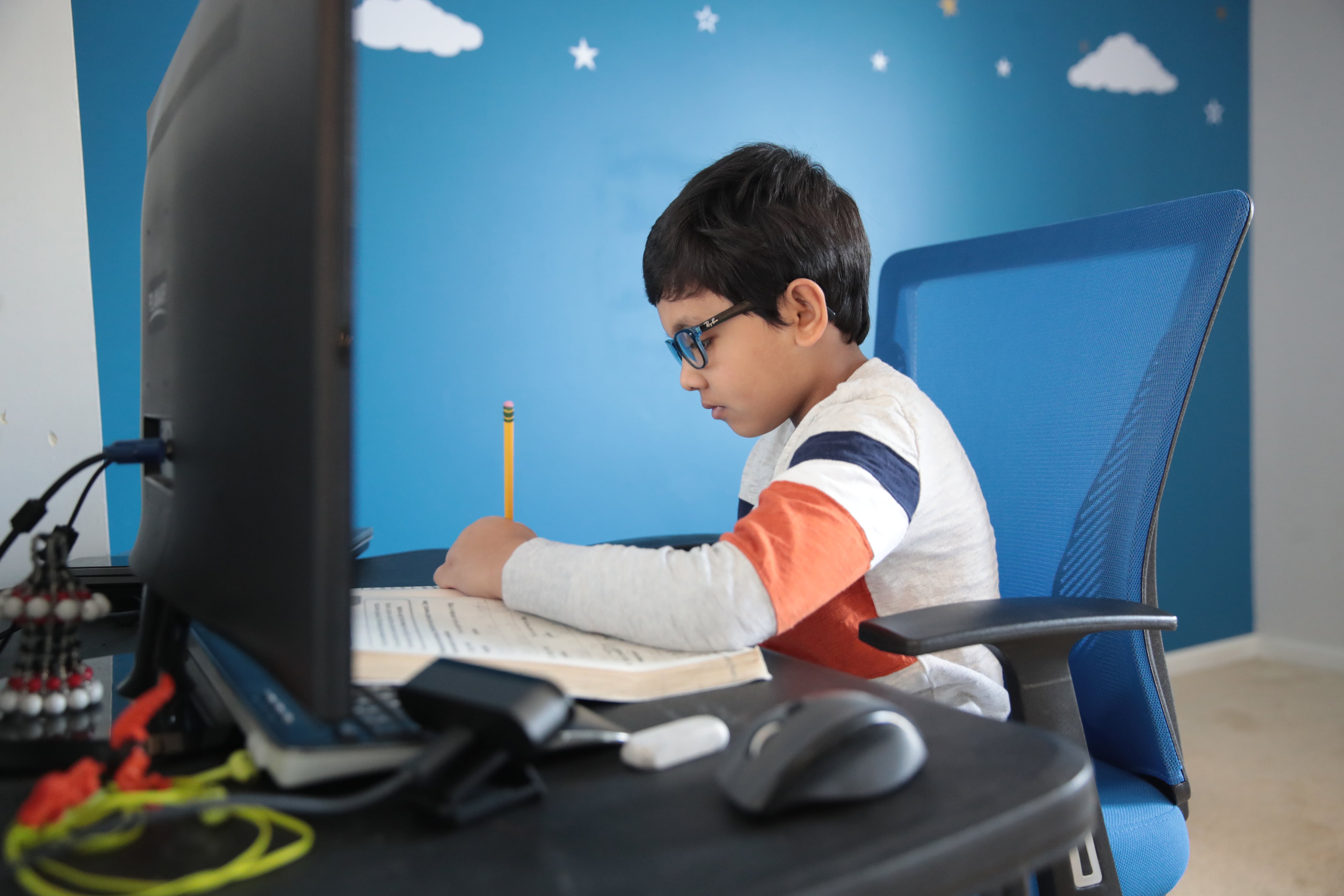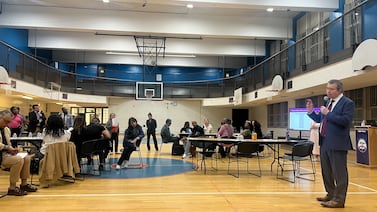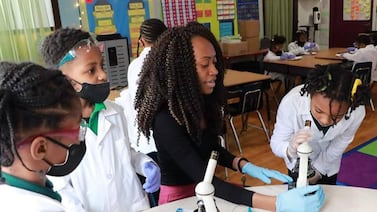The pandemic killed “seat time,” at least temporarily.
Requirements that students spend six hours a day in class, or that a school year must be at least 180 days long, are the bureaucratic backbone of school in many states. When school buildings closed their doors because of the coronavirus, most states also waived those rules.
Now, some are pushing for a permanent re-think.
Advocates of “mastery-based learning” and purveyors of education technology are arguing that it’s the perfect time for schools to allow students to progress through school at their own pace with the help of technology. And some policymakers agree, with schools chiefs in New York City and Cleveland recently expressing enthusiasm for aspects of the idea.
“We’re hearing both from state policy leaders and district leaders: We know that we’re dealing with the immediate crisis, but there is a call to action that we can’t just snap back to the traditional model,” said Susan Patrick of the Aurora Institute, a group that promotes mastery-based and “personalized” learning.
The enthusiasm, though, raises fresh questions about what mastery-based learning looks like in action and whether it actually helps students learn more. Evidence that schools can be effectively reorganized this way is limited, and some observers are worried that the start of an economic downturn and an ongoing public health crisis is not the time to reshape the basics of teaching and learning.
“It’s not like we’re ‘reimagining’ in times of plenty,” said Janelle Scott, an education professor at the University of California Berkeley.
Enthusiasm — and advocacy — is growing for mastery-based learning
A veritable drumbeat of officials, advocates, and philanthropies have been promoting this approach to instruction in response to the coronavirus. Some have even called interest in mastery-based (also referred to as competency-based) learning a “silver lining” of the pandemic.
Sal Khan, the founder of Khan Academy, which offers free online videos for students as well as paid services to school districts, has become one of the faces of this push.
“‘Seat time,’ a term to measure the duration of classroom instruction, won’t seem sufficient when seats may be in different places and times,” Khan wrote in the Wall Street Journal in March, soon after the coronavirus closed virtually every school building in the country. “The idea of individual pacing and mastery of subjects may become mainstream, because they’ll be a necessity.”
“This has forced us now to really embrace this notion of mastery learning,” Richard Carranza, chancellor of New York City schools, said recently in a conversation with Khan.
Advocates say the model allows teachers to help struggling students catch up and let high flyers accelerate. And they argue it’s beneficial in subjects, particularly math, where each concept builds on the prior one.
“In a non-mastery system, you took a test, you got an 80% … and you move on to the next concept,” said Khan. “In a mastery-based system, you say no, you just haven’t mastered it yet. You get as many shots on goal as you need.”
The idea is deeply entwined with education technology, which, supporters say, can help teachers manage and monitor dozens of students on different levels, learning different topics.
What does this actually look like? “It varies radically from school to school,” said John Pane, who has studied personalized learning for the RAND Corporation.
Some classrooms where teachers say they’ve adopted the approach look nothing like the imagined “traditional classroom” with a teacher at the front of the room and every student on the same page of a textbook.
Instead, some students work independently on computers, others meet one-on-one with teachers, and still others work together in small groups. Students prove their mastery of specific concepts in part through a personalized computer program that offers quizzes and tracks students’ progress. Classrooms may mix students across age and grade levels.
In line with that idea, Cleveland is considering replacing traditional grade levels with multi-grade classrooms.
“We’ve got opportunities here to really test, challenge and maybe abandon some of these time-bound structures of education that have never really conformed to what we know about good child development,” said Cleveland’s school district CEO Eric Gordon.
In other cases, a competency-based approach may not lead to dramatic changes in classrooms. When Maine moved to mastery-based high school diplomas, most schools appeared to focus on changing how grades were awarded, rather than how teaching worked.
New York City’s Carranza focused on grading in his comments to Khan about how the city would handle students who struggle during this crisis. “If a student hasn’t mastered that subject area, they’re not going to get a failure — they’re going to get ‘in progress,’ and that says you have some more work to do,” he said.
What is clear is that the coronavirus has made conditions ripe for schools to adopt this kind of instruction.
Grade-level testing, which may constrain educators’ ability to teach above or below grade level, has been canceled this school year. Seat time requirements have been waived. Devices have been rapidly distributed to students in many districts. And remote instruction means some teachers may be naturally allowing students to work at their own pace rather than employing traditional instruction.
There’s not clear evidence that mastery learning helps students learn more
Supporters say they have research on their side. In his Wall Street Journal op-ed, Khan claimed that “decades of research on such ‘mastery learning’ shows that it works.”
A spokesperson for Khan Academy pointed to a widely-cited 1984 paper by psychologist Benjamin Bloom and a 1994 overview of research. But the Bloom paper was based on students learning entirely new subjects, and the large effects have never been replicated in an education setting since. (Khan himself acknowledged this in an interview but said that even much smaller gains are noteworthy.)
More recent research is mixed. Perhaps the most comprehensive study, released in 2017, focused on a few dozen schools that adopted a competency-based, tech-heavy approach with funding from the Bill and Melinda Gates Foundation. (Gates is a Chalkbeat funder.)
Students in these schools saw math scores grow more than students in similar schools that didn’t use these approaches. But the gains were small, and the schools being studied had volunteered for the program, suggesting that these results are the most optimistic accounting.
Other personalized learning tools or models have also not proven their success. A study of Teach to One, a math program, found that students did not see clear benefits on state tests. Summit Learning, which uses a mastery-based approach, hasn’t been evaluated by outside researchers. Khan Academy itself has been subject to little research that can establish cause and effect. Research on Maine’s competency-based overhaul for high schools has been limited.
More optimistically, a number of specific mastery-based computer tutoring programs have shown clear positive results.
“There’s considerable evidence ... that adaptive learning software can produce positive effects,” said Pane, who conducted the Gates-funded study. On the results of efforts to change how entire schools work, he said, “I am not aware of any solid evidence that they are positive.”
Pane he’s been disappointed by the scarcity of research into these ideas and minimal interest from funders and purveyors in seeing their models studied. “Maybe people don’t want to know the answer,” he said.
There are other challenges. A competency-based approach seems more conducive to math, where students learn discrete concepts that students can truly master like dividing fractions or factoring equations.
But how exactly does one master, say, a skill like making inferences from a reading passage, particularly since research shows that students’ reading skills are based in large part on how much they already know about what they’re reading? What about other subject areas that can’t be easily broken down into subcomponents?
The premise of competency-based education “is that all learning can be reduced to a collection of performance tasks. This is fine for simple, concrete skills,” retired teacher Peter Greene wrote. “But more complex skills don’t succumb to merit badge breakdown so easily. You may pass the dribbling test, the passing test, the shooting test, the jumping test, and the blocking test, but does that mean you have achieved mastery of basketball?”
Meanwhile, the debate about the right role for technology in education is fraught, and some parents may worry that less seat time means more screen time. And the economic downtown presents another challenge, as schools will likely face tight budgets and the need to address student trauma and learning gaps. Can they also pull off a reinvention of teaching and learning?
“I feel a little bit like Chicken Little here: I don’t feel like we’ve fully contended with the fact that the sky is falling,” said Scott, the Berkeley professor. “I’m not really sure how we’re going to pay for any of this.”
When Maine attempted to require all its high schools to transition to competency-based learning, a key sticking point for educators was the limited funding for training and other support. Maine eventually repealed parts of the law after increasing backlash. Advocates blamed poor implementation.
There’s little disagreement on the fact that this new approach is not easy to adopt.
Eric Collazo is the principal of Washington Leadership Academy, a D.C. charter school that takes a mastery-based approach to some student grades. He says it’s been quite successful in his school, particularly with an English curriculum for ninth and 10th graders, but that it involved a lot of work to train teachers and build the curriculum.
“There is a lot of legwork,” he said. “That can be a challenge and another lift, especially when we’re at a distance.”







